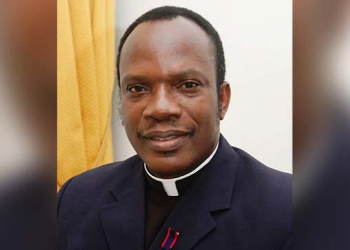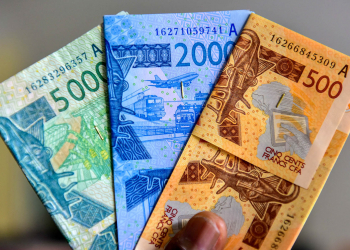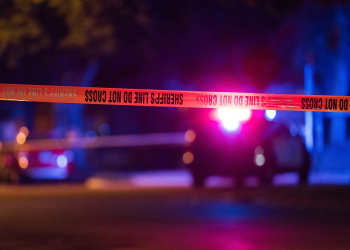News has travelled the world that an organised gang based in Ghana ran a fake embassy selling real US visas for $6,000 (£4,700) for “about a decade”. How did they get away with it for so long?
The US State Department says Ghanaian and Turkish organised crime rings were running the fake embassy complete with a US flag and a portrait of President Barack Obama “unhindered… for about a decade”.
The faded building couldn’t have looked more different to the real embassy.
But, as journalist Sammy Darko in Accra explained on Focus on Africa, the customers have most probably never been to an embassy before so didn’t know what to expect.
“They also find white people there and they assume that it is the US embassy,” he added.
The State Department’s description of the operation gave more insight into how people were deceived.
“The fake embassy did not accept walk-in visa appointments; instead, they drove to the most remote parts of West Africa to find customers. They would shuttle the customers to Accra, and rent them a room at a hotel nearby. The Ghanaian organized crime ring would shuttle the victims to and from the fake embassies.”
The State Department also said the criminals running the operation were able to pay off corrupt officials “to look the other way”.
Have there been any arrests?
Several. That’s as much as we know.
The State Department is vague about this, simply saying “when the task force conducted raids, they arrested several suspects”.
They said that back on 2 November, and added that “several suspects remain at large”.
They added that Ghanaian police have warrants for their arrest and plan to pursue them.
They also said an investigation and search for the Turkish organised crime group was “ongoing”.
The BBC understands, over a month later, that this investigation is still continuing.
It appears to have been a big operation, as the State Department says the sham embassy advertised its services across Ghana, Ivory Coast and Togo.
At the raid, officials found 150 passports from 10 countries.
Why are we talking about this now?
According to the time stamp, the State Department published the news of the arrests on 2 November.
The BBC’s Thomas Naadi in Ghana’s capital, Accra, says the arrests took place a few months earlier than this, in June.
The State Department said an informant tipped off investigators about both the fake US embassy and a fake Dutch embassy at the same time, although it isn’t clear when this was.
It is a bit of a mystery why it was not picked up by media until 2 December. But when it was, it was widely shared on social media.
Three days later, and the media is getting more creative with their headlines.
The Washington Post has gone with “Mobsters ran a fake US embassy in Ghana for 10 years, flying the flag and issuing visas for $6,000”.
Were the visas genuine?
The State Department said the embassy provided some customers “fraudulently obtained, legitimate US visas” as well as counterfeit visas, false identification documents (including bank records, education records, birth certificates, and others).
It says the operation paid corrupt officials to obtain legitimate blank documents to be doctored.
Did the customers care if the embassy was fake?
We don’t know for sure whether the customers knew if the embassy was fake.
But if they did, they had strong motivations to proceed regardless.
Travelling to the US is a big thing for many Ghanaians who are desperate to reach the US as they are convinced it is an opportunity for them to better their lives, explains the BBC’s Adelaide Arthur.
Also, being refused a visa can be very disheartening for prospective travellers and this often makes them vulnerable to scammers who promise them a visa, she adds.
How many people used this service?
The State Department has not commented on this.
We also don’t know what kind of visas people were buying.
We may never know how many people are living in the US with visas issued from the fake embassy.
It is not clear if the US authorities will try and take any action against them.
How does it compare to the official procedure?
The official application has many stages.
When the BBC’s Adelaide Arthur, who is Ghanaian, went through the procedure herself, the first stage was to pay a visa fee at the bank.
After paying the fee, she was given a code which would allow her to submit a form which she filled in on the US embassy’s website. The type of form you fill in depends on your purpose of visit. Her visit was for media, so she applied for a visa Class I. But people applying to visit the US usually choose visa B1/B2.
After filling in the form, she uploaded a passport-sized photograph which had to conform to specific dimensions. She was then allowed to set her interview appointment date which was within two weeks of submitting her application form online.
On the interview day, she arrived at the visa section of the embassy in the upmarket suburb of Cantonments in Accra.
“The imposing building that houses the US embassy is hard to miss when travelling around that area, where a number of missions are also located, including the South African, Italian and South Korean embassies,” she said.
She attended the interview with her application submission confirmation, appointment confirmation, passport, visa fee receipt, as well as other supporting documents, including proof of employment and financial support.
Her fingerprints were taken before her interview with a consular officer.
Usually, the applicant is made aware of the decision after the interview with a consular officer.
In her first attempt, she was refused the visa immediately after the interview and was given back her documents.
Two subsequent applications were however, successful and she was told to come back two days later for her visa.
Join GhanaStar.com to receive daily email alerts of breaking news in Ghana. GhanaStar.com is your source for all Ghana News. Get the latest Ghana news, breaking news, sports, politics, entertainment and more about Ghana, Africa and beyond.




